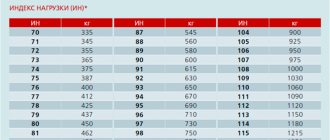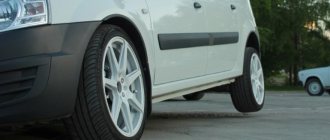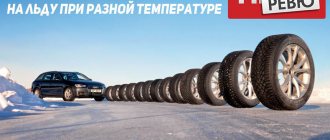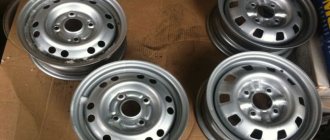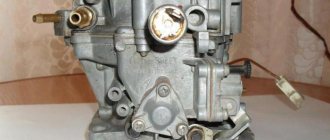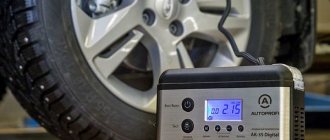How to determine the direction of tire rotation?
Modern tires have a certain type of tread pattern. This pattern can be: non-directional, directional and asymmetrical. Thanks to this variety, sometimes you can get into an unpleasant situation when the car, for unknown reasons, starts to drive to the right or left, while the wheel alignment is set correctly. In this situation, most likely, during the next “change of shoes” from summer to winter or from winter to summer, the wheel was installed incorrectly. How to determine the direction of tire rotation in order to avoid such situations? You will find the answer in this article.
Definition
Correctly determining the direction of tire rotation is quite simple - when the car moves forward, the “herringbone (tread pattern)” should touch the road surface first. When stopping, it is necessary that the tread pattern faces the direction opposite to movement.
The determination method is suitable for both summer and winter tires.
Tire rotation direction
Some tires (for example, Bridgestone) can be swapped. This is done only crosswise. This means that it is possible to drive 45-60 thousand kilometers, and after that change the location of the wheels. It is possible to put a front left one in place of the right rear one, and a front right one in place of the left rear one. This can be done with the front wheels, but in a strictly defined order.
If the direction of tire movement is specified, the wheels are rearranged on one side, i.e. Front tires are swapped for rear tires and vice versa.
When the tires are symmetrical, it is possible to change the arrangement in any order.
Installing Bridgestone asymmetric tires does not require highly skilled skills if you remember a few instructions. The inscriptions “Inside” and “Outside” must be strictly established according to the rules.
Directional tires must be installed so that when driving, the wheel moves in the direction indicated by the arrow. When installing, you need to focus on moving forward.
Symmetrical (non-directional) tires are installed at the discretion of the owner. Therefore, they do not have any instructions for installation.
Important: if at least one wheel is installed incorrectly, then vehicle control will deteriorate sharply, and the tires will quickly become unusable!
Installation is best done as follows:
- Loosen the mounting bolts. To raise
Correct installation of asymmetric tires
car, you need a jack and a flat surface. After which the old wheels are removed and new wheels are installed.
Proper installation of summer, winter or all-season tires guarantees that the tires will maximize their driving performance, and car owners will be able to feel comfortable and safe at any time of the year, and on any road surface.
The importance of directional tire installation for different tread types.
So, as noted earlier, tires can have a non-directional, directional and asymmetrical pattern.
It is this pattern that determines the requirements of tires for directional installation:
- non-directional tires, by the way, the most budget option, work equally in any direction of rotation;
- asymmetrical - require careful installation, since such tires have a strictly defined direction of rotation - the inner side (indicated on the tire by the word “inside”) and the outer side (indicated by the word “outside”);
- directional - the most demanding in terms of their installation; they have a specific tread pattern that resembles a herringbone. This pattern has grooves for draining water when the tires come into contact with the road surface, due to which the risk of a phenomenon such as hydroplaning, when a car, moving on a wet road surface at high speed, begins to lose contact with the road, is minimal.
That is why the question of the direction of tire rotation is most relevant for owners of tires with a directional tread pattern. Fortunately, today almost all manufacturers put “hints” on their tires: large arrows are drawn on their sidewalls, which precisely indicate the required direction of rotation. Although there may be only one arrow, then the word “Rotation” will be present next to it.
If they are not there, know that tires with a “herringbone” should be installed so that the top of this herringbone touches the road first when rotating, that is, it looks in the direction opposite to the movement of the car.
Please note that in some cases there are tires that have both an asymmetrical and directional tread pattern. They should be installed according to generally accepted markings.
Advantages and disadvantages, installation features
Advantages of tires with an asymmetric tread layer:
Disadvantages: significant disadvantages were present in asymmetric tires with a directional tread pattern, but this type of tire has been discontinued.
Installation of rubber with an asymmetrical tread pattern is carried out taking into account the outer and inner sides of the product. You can find out which side to mount the tires by looking at the corresponding inscription on the side of the tire. Their outer side has one of the designations:
- outside;
- side facing forwards;
- external.
The inside of the tire has one of the markings:
- this side facing inwards;
- inside.
When installing such tires, the direction of the tread pattern does not matter. Correct installation involves placing tires depending on the outside and inside of the tire.
How to determine if tires are directional or not
Modern tires have a certain type of tread pattern. This pattern can be: non-directional, directional and asymmetrical. Thanks to this variety, sometimes you can get into an unpleasant situation when the car, for unknown reasons, starts to drive to the right or left, while the wheel alignment is set correctly. In this situation, most likely, during the next “change of shoes” from summer to winter or from winter to summer, the wheel was installed incorrectly. How to determine the direction of tire rotation in order to avoid such situations? You will find the answer in this article.
The importance of directional tire installation for different tread types.
So, as noted earlier, tires can have a non-directional, directional and asymmetrical pattern.
It is this pattern that determines the requirements of tires for directional installation:
- non-directional tires, by the way, the most budget option, work equally in any direction of rotation;
- asymmetrical - require careful installation, since such tires have a strictly defined direction of rotation - internal (indicated on the tire by the word “ins>
That is why the question of the direction of tire rotation is most relevant for owners of tires with a directional tread pattern. Fortunately, today almost all manufacturers put “hints” on their tires: large arrows are drawn on their sidewalls, which precisely indicate the required direction of rotation. Although there may be only one arrow, then the word “Rotation” will be present next to it.
If they are not there, know that tires with a “herringbone” should be installed so that the top of this herringbone touches the road first when rotating, that is, it looks in the direction opposite to the movement of the car.
Please note that in some cases there are tires that have both an asymmetrical and directional tread pattern. They should be installed according to generally accepted markings.
Tread direction: meaning and definition
The tread pattern of a tire is an important characteristic that determines its basic properties.
Not everyone knows, but depending on the depth and nature of the pattern, tires are divided into winter and summer. Also of great importance is the direction of the tread, which increases grip on wet roads and improves the outflow of water, snow, dirt, i.e. increasing the driving characteristics of the car as a whole. Why know the direction?
The direction of tire rotation plays an important role when installing wheels. Indeed, in addition to directional ones, there are also non-directional protectors, symmetrical and asymmetrical. How to determine the direction of the tire on these models? The manufacturer applies appropriate markings to its products. A whole team of engineers, technologists and other specialists is working on the development of the tread pattern. Installation in the opposite direction not only nullifies the work of a large team, but also makes the purchase of such models (often more expensive) pointless.
If installed incorrectly, tires wear out faster, the car becomes less stable, holds the road poorly, and fuel consumption increases. Those qualities that should have improved are, on the contrary, deteriorating.
Installation Features
To show the direction of the pattern, an arrow and the inscription “Rotation” are placed on the tires. Both directional and non-directional products can be marked in this way.
| Arrow on the tire | "Rotation" inscription |
How to determine the tread direction of tires with an asymmetric pattern? Everything is simple here too. Models common in our country are marked with the inscriptions “Outside” (outside) and “Inside” (inside). The wheels are installed accordingly. It's difficult to confuse.
| Out and in |
Not so long ago, strictly left- and right-handed tires were produced that had good driving performance, but due to the high cost of production and operation, and constant confusion in warehouses, their production was abandoned.
It is easiest to determine the rotation of a tire with a symmetrical tread pattern. There is no direction or strictly defined sides. Tires can be installed in any position. This is ideal for a spare tire.
Some tips
When purchasing a new set of tires, decide what type of road surface you will be dealing with most often. Depending on this, choose the tread pattern and its direction.
Remember that driving with incorrectly installed tires is dangerous and the car's controllability is reduced. If the situation forces you to temporarily drive on such a tire, adhere to the speed limit and be extremely careful.
Source
Advice.
If you encounter difficulties in determining the direction of tire rotation, do not hesitate to consult specialists who will help you understand all the nuances and also provide more accurate information on this issue.
Approach the issue of installing tires competently and wisely, because your safety depends on it!
The modern tire industry is creating its products better and better. Universal products are able to feel great on dry asphalt, drain water, provide traction, and in addition, provide acoustic comfort and reduce fuel consumption.
For modern cars, many sets are offered with a variety of treads and mixture compositions. This versatility has one drawback. The tread pattern differs between the halves of the tire. Therefore, there are Rotation, Inside or Outside marks on the tires, indicating the correct direction of rotation.
In this article we will talk about marking the direction of tire rotation, types of rubber, directional and non-directional tread patterns, and also tell you about all the pros and cons of such products.
Wheel installation direction Sava pattern
Mark Sava is from Slovakia. Directional and equilateral tire models that are in demand in Europe are produced here. The brand's products are popular due to their good combination of price and quality.
Regarding the direction of the drawing, it all depends on the type of model and intended application. The model range includes varieties of all designs.
Directional slopes are installed according to the arrows, asymmetrical ones are installed according to the inscriptions Outside and Inside.
What is rotation on tires
The main factor to pay attention to is the tire tread. A well-chosen pattern will maximize the contact patch with the road and help drain water and slush, preventing rubbing. Wheels come in both directional and non-directional patterns or asymmetrical structure. They differ in technical characteristics, production costs and recommended conditions of use.
How to find out the direction of the tires?
Recognizing rubber with a directional pattern is quite simple. On the sidewall there may be an arrow and the inscription Rotation, indicating the movement of the car forward. If there is no such marking, then we have a non-directional tread and the direction of the tire does not matter.
You can also visually determine the direction of rotation of the tire. For effective drainage of water from the tread, the guides should go from the center of the disc to its edges. If the pattern matches, then the wheels are installed correctly. If not, then perhaps this direction of rotation is incorrect and you should pay attention to this by checking with the marks on the side of the wheel.
Kits often contain additional symbols that provide useful information. For example, you can see twi marks on a tire; these are indicators that indicate the degree of tread wear. The last mark is at the minimum permissible height of 1.6 mm. Marks like these help you understand which tires need replacing and keep track of your tires.
Questions often ask about what M+S means. M+S marks are primarily placed on all-season tires. The literal designation is Mud+Snow, that is, the ability to work effectively on mud or snow. However, it is worth remembering that there is no universal solution and it is impossible to fit the best ones into one set of tires.
All-season wheels work best at near-zero temperatures, so in fact such wheels are demi-season. If the thermometer fluctuates significantly in any direction, the tire performance deteriorates significantly compared to the installed seasonal sets. Therefore, it is advisable to have summer and winter tires.
Step-by-step instructions on how to properly install wheels on a car
Now you know how to properly install wheels depending on the type of tire. Let's look at how the replacement is performed. In order to properly dismantle and install a new wheel, you should study the owner's manual for your car. There you will find all the necessary information on how to properly install the wheels. Here is the general sequence of actions when replacing:
- We dismantle tires; To do this correctly, you need to unscrew the nuts. Moreover, you don’t need to unscrew them completely, just loosen them. For greater safety, unscrew the nuts manually. However, if you have experience with an impact wrench, you can use one. Otherwise, get a simple car key.
- Using a jack, we raise the car. It must be parked on level asphalt. After this, you can unscrew the nuts and remove the tires.
- We distribute tires in advance, so it will be more convenient for you to work. To do this, place them next to the old wheels. Don't forget about the arrows indicating the direction of rotation, the tread pattern, and the sides of the tires. Inspect the nuts. Did you see that they have rough edges and are difficult to tighten? Then the thread should be restored. This can be done using a special kit, which is sold at any auto store.
- We clean brake discs and drums if they are dirty or rusty.
- We make sure that the wheels sit properly on the hub. If the center of the disc is even slightly deviated from the center of the hub, the wheel will start to hit. While driving, you will notice that there are vibrations on the steering wheel. If you install the wheel incorrectly, the mount will break.
- To prevent the bolts from rusting, they should be coated with a wax lubricant or other special compound.
- We install tires correctly. To do this you need to tighten the bolts a little. Then remove the jack from under the car and tighten the nuts completely.
- We perform the final check. Take a close look at the wheel. The outer edge of the disc and the inner side of the rim should not touch. To eliminate this, run your palm over the wheel. After this, pump up the tires if necessary.
You need to know how to position the wheels correctly, because if you make a mistake, driving your car will become unsafe. Do you prefer to change your tires at a tire station? In this case, you also need to know how the job is done. This is the only way you can be sure that everything is done correctly. The fact is that even a tire fitting specialist can make a mistake or deliberately do a poor job.
Inner and outer side of the tire
Markings on the outside or inside of the tire are extremely important in order to install the tires correctly. Therefore, let us briefly summarize the material presented above:
- The most universal is non-directional symmetrical rubber, which can be placed in any place without removing it from the disk; directional - no. Therefore, it is worth having a spare tire with such a tread - this will make the situation easier when necessary;
- outside markings, like inside marks on tires (translation: outer or inner side), indicate an asymmetrical tread pattern. The inscriptions are printed on the sides of the product. These wheels have two different tire sections for dry or wet pavement;
- asymmetrical rubber provides more confident grip on the road, excellent water drainage, and a maximum contact patch. However, such tires cannot be swapped relative to the left or right side of the car;
- the cost of such sets is 10-15% higher than similar tires with a standard pattern;
- When installing asymmetrical sets or tires with a directional pattern, the tread pattern and the direction of wheel movement should be taken into account. You can learn more about all the tricks of tire fitting from professional videos.
Which direction should you install Yokohama Ice Guard tires?
Old versions of Ekohama Ice Guard tires had a symmetrical, directional tread type, where it was almost impossible to confuse the place or side of installation.
In 2021, the manufacturer introduced a new generation of the model to the Russian market. The asymmetry of the shape of the working area is clearly visible here. Due to the design change, new markings appeared on the tire. Internal and external honor indicators are located on the sidewalls, where “Outside” is the outer side.
How to determine which side to put the tires on?
The most important property of any tire is to provide reliable grip on the road surface. This task is performed by the tread rubber, “fitting” due to its elasticity the micro-roughness of the road in the contact patch. In wet weather, even at low speeds, a film of water forms between the tread and the road, preventing their contact with each other. To prevent loss of controllability in such conditions, it is necessary to remove water from the contact patch, so both longitudinal and transverse grooves of various shapes are made on the tread. To better remove dirt, which is more viscous than water, from the contact patch, the grooves should be wider. However, as the number of grooves or their width increases, the load on the tread protrusions increases and traction on dry pavement deteriorates due to a decrease in the area of contact of the rubber with the road. In addition, a large load on the tread lugs accelerates tire wear. The characteristics of each specific tire are achieved through a complex combination of design features, tread pattern and the quality of the rubber compounds used. The noise level during rolling, wear resistance, and road grip depend on the tire tread and its pattern. Often designers improve one or two parameters to the detriment of others, for example: reducing noise and increasing smoothness at the expense of some reduction in stability and controllability. It is impossible to achieve high assessment results for all indicators simultaneously with one type of tire. Therefore, the number and variety of tires and tread patterns produced cannot even be described, since more and more original samples appear every year. More information about tire markings:
TYPES OF TIRE
, road, all-season and universal ones are most widely used.
types of tires.
Road tires
(commonly called summer tires) are designed for use at positive temperatures on highways.
Tires of this type provide the best grip on dry and wet hard surfaces, fuel efficiency, have maximum wear resistance and are best suited for high-speed driving. They are of little use for driving on dirt roads (especially wet ones) and in winter. The tread pattern is distinguished by clearly defined longitudinal grooves for draining water from the contact patch between the tread and the road, weakly defined transverse grooves and the absence of a micropattern. In addition, they have a mandatory smooth (rounded) transition from the tread to the sidewalls. All-season tires
are a compromise between summer and winter tires, and therefore are inferior in terms of traction when used in the corresponding season.
They are adapted to work on dry and wet asphalt, for winter roads, provide a good level of comfort and satisfactory efficiency, but are characterized by slightly greater wear than summer ones. One set of such tires ensures acceptable performance of the vehicle during year-round operation. The tread pattern of an all-season tire is more branched, with the elements of the pattern grouped into a clearly visible “track” and separated by grooves of different widths. Large elements of the pattern have narrow slots (lamellas) that provide traction on icy or snowy roads. As a rule, these tires are marked with all season, tous terrain or conventional symbols (snowflake or drop). Universal tires
(according to domestic terminology) are designed to work on roads of any quality. Moreover, it can be quite difficult to draw a clear boundary between them and all-season ones. They differ primarily in their deeper and more branched tread pattern. The fact is that roads of “any quality” in the CIS can be understood as 60–80% of all roads, including off-road, so this type of tire is in many ways a domestic invention. By Western standards, tires of the M+S type (Mud and Snow - mud and snow) can be classified as universal tires in a version with a tread pattern less dissected by grooves, with a weakly expressed micropattern or without it.
Non-directional tires
The second type is a non-directional pattern. Tires with a pattern of this type are used on cars that do not reach high speeds. There are fewer and fewer such cars every year. Even the traditional consumer of non-directional tires, UAZ, has stopped installing them regularly on its classic Hunter SUV.
Non-directional tires are still in demand among jeepers, since real mud tires, as a rule, have a non-directional pattern. There is a logical explanation for this - for a jeep stuck in the mud, it is vitally important to be able to move backwards while maintaining maximum grip on the “covering”. However, most fans of off-road sports keep these tires, mounted on a separate set of wheels, in the garage, changing them only for competitions. Tractor tires with a herringbone pattern are highly respected among jeepers. Its advantage is that the herringbone protrusions in the pattern are so rare that dirt, sand or gravel cannot be clogged purely physically in the spaces between them. Surprisingly, these are directional tires.
There is also a tire tread pattern for off-road vehicles. Its design feature is that it has so-called “lugs” that compact the soft medium and thereby provide sufficient adhesion to the coating.
TREAD PATTERN
The tread pattern is formed by a certain arrangement of its elements relative to each other and the direction of rotation of the tire. On any type of bus, non-directional, directional
or
an asymmetrical
tread pattern, which has a significant impact on its performance characteristics.
1 - non-directional tire is installed on the car arbitrarily; 2 - a directional tire is installed on the car in the direction of the arrow on its sidewall; 3 - an asymmetric tire is installed on a car in accordance with the inscription on its sidewall: “Outside”
- outer side;
“Inside”
- inner side
Non-directional
is the most universal pattern, so some tires are produced with it.
It allows arbitrary wheel installation and any direction of tire rotation, but is inferior to other designs in its ability to intensively remove water from the contact patch with the road. A directional
pattern is distinguished by the fact that its elements (simplified) diverge in a herringbone pattern, and this requires a certain direction of rotation of the wheel.
This arrangement of elements makes it possible to remove water and liquid dirt from the contact patch more effectively than with a non-directional pattern and reduce the level of noise created by the tire when driving. The direction of rotation must be indicated on the sidewalls of tires with this design. A certain inconvenience is due to the fact that the “spare wheel” coincides in the direction of rotation only with the wheels of one side of the car, and on the other side it can only be used for traveling at low speed to the nearest tire shop. An asymmetrical
pattern is one way to implement different properties in one tire, for example, the outer side of the tread is made with a pattern that provides the best grip on dry roads, and the inner side - on wet roads. It is characterized by a different arrangement of grooves and blocks on one and the other side of the middle of the tread. Tires with an asymmetric pattern are most often non-directional, and occasionally directional; in this case, different tires are required for the left and right wheels of the car. The sidewalls of tires with an asymmetrical pattern must indicate which side should be directed inward and which outward. If the tire set has an asymmetrical non-directional pattern, then the spare tire fits on either side of the vehicle.
Let's find out how to do the installation correctly
Before determining the direction of the tire, it is important to know that the Goodyear tire direction marking for an asymmetric pattern is indicated: LEFT - left; RIGHT - right; outside - external side, inside - internal. install tires on the car according to the pattern on the tread or arrow. If they are symmetrical, follow the symmetrical pattern, its direction should coincide with the direction of movement of the wheel. If you need to install in a direction, the correct designation is ROTATION - rotation.
How to find out the direction if there is no marking - a herringbone pattern? Rotate the tire in both directions - the top of the herringbone should touch the road first. This is the correct way to install a wheel without marking the direction of rotation.
Recently, manufacturers have switched to symmetrical wheels, since it is impossible to know which one will fail. Correct replacement scheme:
- loosen fasteners;
- lift with a jack;
- unscrew the fastener completely;
- remove the tire;
- put on a new one;
- gradually secure the wheel; — do not tighten the fasteners completely;
- lower the jack;
- tighten fasteners.
It is also worth understanding that you cannot use anti-corrosion agents on the road to treat fasteners - imbalance. You can recognize the accuracy of balancing by the absence of knocking. The same method can be used to determine the correct installation.
Correct installation is impossible without balancing the rotation on a special machine. It is impossible to install a tire without a tube without the appropriate equipment. It is important to understand that you cannot install tires from different manufacturers on one vehicle - non-uniform depreciation is the result of suspension knocking. You shouldn’t skimp on load-carrying capacity and elasticity; replacing the chassis will cost more.
“Price From” means the suggested retail price of the Product and may differ from the price of the Product offered by Goodyear dealers. The materials presented on this site are for informational purposes only and do not constitute a public offer in accordance with Article 437 of the Civil Code of the Russian Federation.
* Please check with your dealer for specific terms and conditions of each current promotion. The materials presented on this site are for informational purposes only and do not constitute a public offer in accordance with Article 437 of the Civil Code of the Russian Federation
RECOMMENDATIONS
Some general guidelines may be helpful when selecting and using tires. • Use tire sizes recommended in the vehicle's owner's manual. • Since there are no ideal tires, when choosing them it is advisable to determine for yourself which properties, in addition to reliable grip, are most important - “sportiness”, comfort, efficiency, etc. • A tire for comfortable highway driving, while having low noise and good ride comfort, may not provide good stability and controllability at high speeds. • The tire has an increased service life and provides reduced fuel consumption (compared to other models) due to low rolling resistance, but may not provide good comfort. • As a rule, manufacturers indicate in advertising brochures what exactly the best properties a given tire model has, but at the same time they are silent about what properties they “sacrificed” for this. • By selecting tire parameters when replacing them, you can improve some vehicle performance, but certainly at the expense of others. • Low profile tires will improve vehicle handling, especially at high speeds, but they are more susceptible to damage on rough roads. • Only external similarities or, conversely, differences between tires from different manufacturers do not allow us to draw an unambiguous conclusion about the similarity or difference in their performance properties. • All tires, even within the same type, vary in rubber chemistry, internal construction and tread pattern. • The use of winter tires in the summer, in addition to their accelerated wear, worsens the directional stability, handling ("cotton steering wheel") and braking properties of the car.
Design Features
The structural features of rubber are distinctive features that increase the driving characteristics of the vehicle. It is important to understand them in order to choose the right replacement tires.
Tubeless, in case of a puncture they retain elasticity for a long time. The rubber tightens around the stuck object. Does not overheat when moving, due to heat removal by the open (metal) part of the rim. In contrast to the tube type, there are increased requirements for the rims, the need to apply additional sealant at the junction of the rim and rubber, and the complexity of installation. Tubeless ones are used more often; if mounted correctly, they have high wear resistance.
